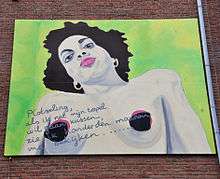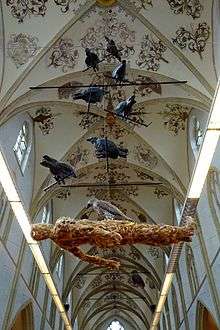Lydia Schouten
Lydia Schouten (born 1948, Leiden, Netherlands) is an internationally-known Dutch performance and video artist.[1] Early in her career she critiqued traditional women's roles and the portrayal of women as sex objects. More recently, her work considers themes of loneliness, sex and violence.[2] As of 2004, she lives in Amsterdam.[3] Her work has been exhibited internationally and she has held artist in residencies in several countries. Schouten received the Maaskant Award from city of Rotterdam in 1975.
Lydia Schouten | |
|---|---|
| Born | 1948 |
| Nationality | Dutch |
| Education | Free Academy in The Hague, Academy of Fine Arts |
| Website | http://www.lydiaschouten.com/ |

Education
Schouten studied at the Free Academy of Visual Arts in The Hague from 1967 to 1971 and at the Academy of Visual Arts in Rotterdam from 1971 to 1976.[1]
Work

From 1978 to 1981 she was mainly concerned with performance art, from 1981 to 1988 mainly with video art.[1] She frequently appears in her videos, e.g. Romeo is bleeding (1982).[4] In 1984, her work was included in The Luminous Image, an international exhibition of video art at the Stedelijk Museum.[5] She was a member of the Time Based Arts Foundation, an organization of video artists.[6][7] Since 1988 she has focused on installations with photography, sound and video as key components.[1] Her work has been described as "a rhetorical corruption of the icons of popular culture"[8] which is at times both "shocking" and "poignantly beautiful".[9] She herself has said that her work often involves overcoming her own fears.[10]
She has received travel grants from the Ministry of Cultural Affairs (1981, 1982)[3] and has been an artist in residence in Curaçao, New Zealand, Canada, the United States, and Germany as well as her native Holland.[11] Her work has been exhibited at the Museum Ludwig in Cologne,[12] the Centre Georges Pompidou in Paris, the Torch Gallery in Amsterdam, the Institute of Contemporary Art in New York City and the Metropolitan Museum of Photography in Tokyo.[13]
Her travels to New York, which was originally settled by the Dutch in 1609, have inspired works such as her media installation A Song for Mannahata.[10] Lydia Schouten has done work for public spaces, such as the Monument voor de Verdronken Dorpen in Zeeland ('Monument to the Drowned Villages') in Colijnsplaat. The monument includes a tower with speakers and a sound installation which serves as a reminder of the 117 villages, and their populations, which were flooded during the Flood of 1953.[14][15]
Exhibitions
Schouten is in the show "Feminist Avantgarde from the Seventies” which has been traveling around the world since 2016.[16]
Awards
In 1975, she received the Maaskant Award from city of Rotterdam.[3]
References
- "Lydia Schouten, Artist in distribution, Netherlands, 1948". LIMA preserves, distributes and researches media art. Retrieved 13 February 2017.
- "Lydia Schouten". CULTUREEL WOORDENBOEK. Retrieved 13 February 2017.
- "Lydia SCHOUTEN". EWVA European Women's Video Art. Retrieved 13 February 2017.
- "Romeo is Bleeding Lydia Schouten, 1982, 11'18"". LIMA. Retrieved 13 February 2017.
- Lopez, Sebastian (2005). A short history of Dutch video art. Rotterdam: Episode Publ. ISBN 9789059730311. Retrieved 13 February 2017.
- "The story of the collection". LIMA. Retrieved 13 February 2017.
- "History of the Collection". Netherlands Media Art Institute. Retrieved 13 February 2017.
- "Please wait... The Magnetic Era: Video Art in the Netherlands: 1970-1985". Daniel Langlois Foundation. Retrieved 13 February 2017.
- Perrée, Rob (2006). "Lydia Schouten: Le Jardin Secret (E)". Rob Perrée : Art and Literature.
- Westen, Mirjam (2015). "The Beauty of Both & A Song for Mannahata". Witteveen Visual Art. Retrieved 13 February 2017.
- "Study and residencies". Lydia Schouten. Retrieved 13 February 2017.
- "Lydia Schouten: A titkos kert 2006. május 11 - 2006. július 2". Ludwig Museum. Archived from the original on 20 March 2017. Retrieved 13 February 2017.
- "Lydia Schouten". Galeries.NL. Archived from the original on 20 March 2017. Retrieved 13 February 2017.
- "Monument for the drowned villages of Zeeland (2009)". Lydia Schouten. Retrieved 13 February 2017.
- "Monument for the drowned villages of Zeeland (2007)". Lydia Schouten. Retrieved 13 February 2017.
- "L y d i a S c h o u t e n | Biography". www.lydiaschouten.com. Retrieved 2019-03-01.